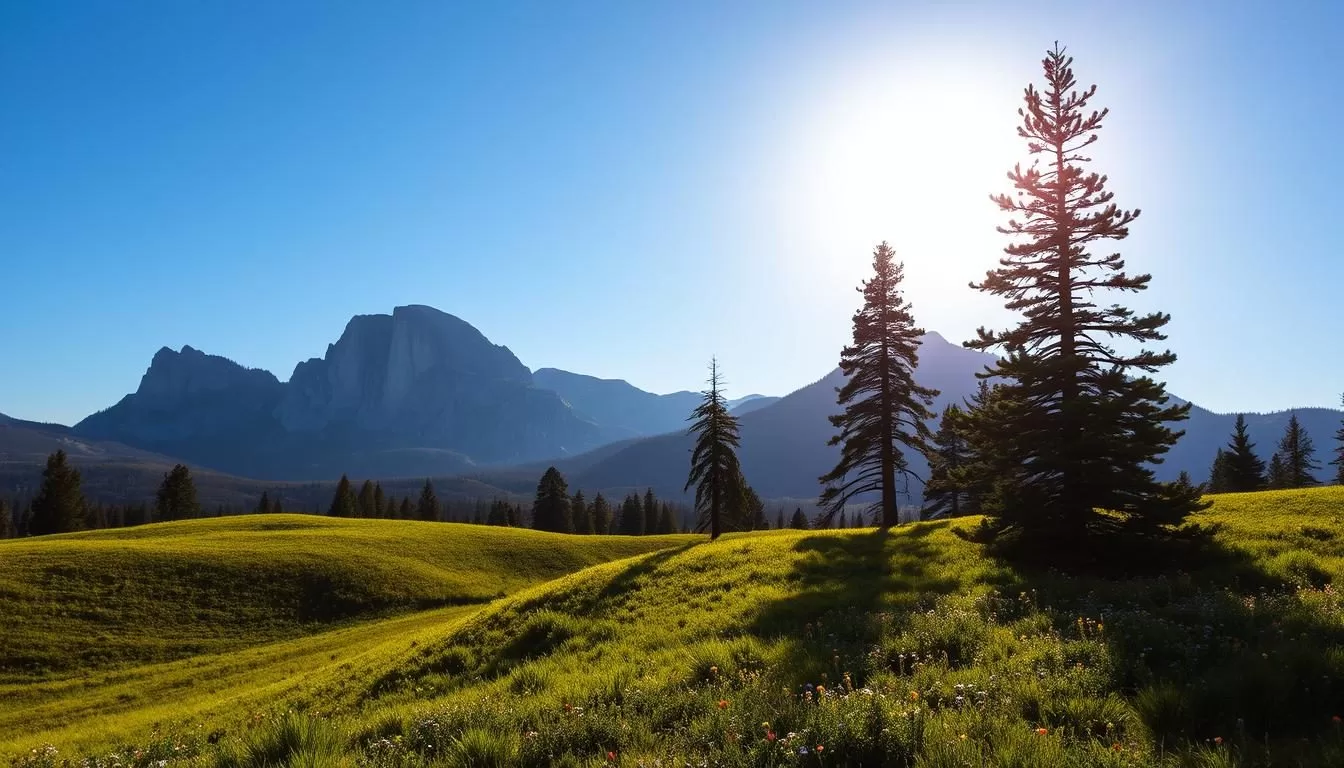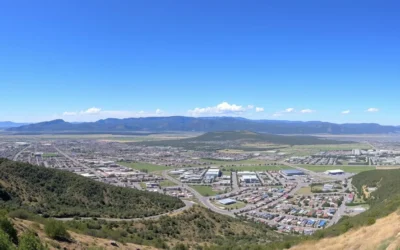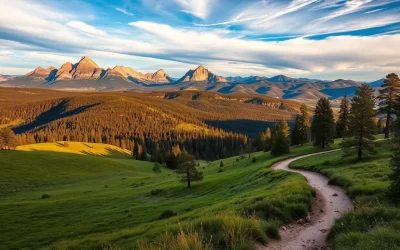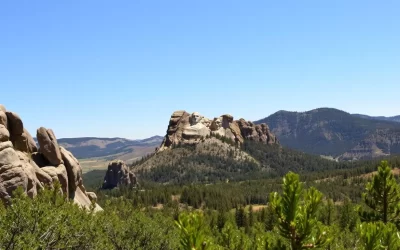Planning a trip to Sturgis requires understanding the region’s distinct seasonal weather patterns to make the most of your visit.
The Black Hills region surrounding Sturgis offers diverse attractions and activities that are best enjoyed during specific weather conditions.
Over the course of the year, the temperature typically varies, making some months more suitable for your travel plans than others.
This guide will help you identify the ideal time for your Sturgis adventure based on your preferences for weather, crowds, and available activities.
Understanding Sturgis’ Unique Climate
The climate in Sturgis is shaped by its geographic location, resulting in a unique blend of temperature fluctuations and precipitation patterns. Located in the Black Hills region of South Dakota, Sturgis experiences a continental climate with varied temperatures throughout the year.
Geographic Influences on Weather Patterns
Sturgis’ geography plays a significant role in shaping its weather. The city’s location in the Black Hills region means it is surrounded by mountains, which can influence the flow of air and lead to varied precipitation patterns. This results in a climate that is characterized by hot summers and cold winters, with rain and snow contributing to the region’s annual precipitation.
Annual Temperature and Precipitation Overview
Sturgis experiences a wide range of temperatures throughout the year. The hot season lasts for 2.9 months, with an average daily high temperature above 76°F. July is the hottest month, with an average high of 85°F and low of 60°F. In contrast, the cold season lasts for 3.8 months, with an average daily high temperature below 46°F. January is the coldest month, with an average low of 18°F and high of 37°F.
| Season | Average High Temperature | Average Low Temperature |
|---|---|---|
| Summer (July) | 85°F | 60°F |
| Winter (January) | 37°F | 18°F |
| Annual Snow | 45 inches | |
With approximately 230 days of sunshine per year, Sturgis offers pleasant conditions for outdoor activities during most seasons. The region receives an average of 45 inches of snow annually, with March often seeing the heaviest snow accumulation.
Summer in Sturgis: Peak Season Experience
Summer brings a unique flavor to Sturgis, with each month offering distinct experiences and events. As you plan your trip, understanding the nuances of each summer month can help you make the most of your visit.
June Weather Conditions and Activities
June marks the beginning of summer in Sturgis, with mild temperatures and a plethora of outdoor activities. The average high temperature is around 75°F, making it ideal for hiking and biking through the beautiful Black Hills. You can enjoy scenic drives through Custer State Park, exploring the wildlife and natural beauty.
July’s Hot Days and Thunderstorm Patterns
July is characterized by hot days with average highs reaching 86°F. It’s also a time when thunderstorms are more frequent, bringing sudden changes in weather. Visitors should be prepared for these thunderstorm patterns by staying informed about local weather forecasts. Despite the heat, July is a great time for water activities in the Black Hills.
August and the Sturgis Motorcycle Rally
August is perhaps the most iconic month in Sturgis due to the Sturgis Motorcycle Rally, attracting over 500,000 visitors. The rally transforms the town into a bustling hub of activity, with the winding roads through the Black Hills becoming showcases for motorcyclists. The average high temperature is around 84°F, and while the crowds can be significant, the event adds a unique dimension to your visit.
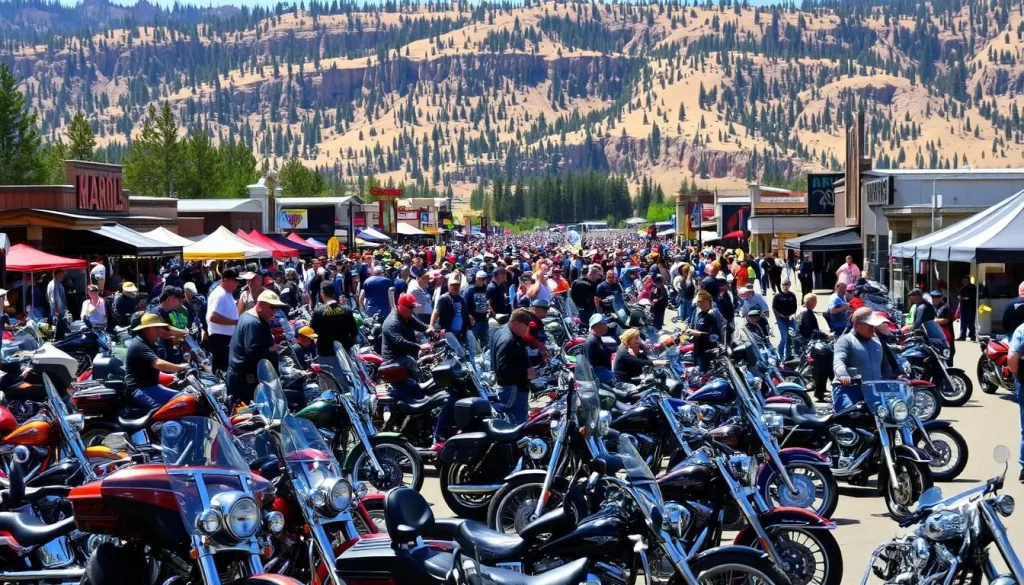
If you’re not interested in the motorcycle culture, it’s advisable to avoid the first two weeks of August. However, late August sees a rapid decrease in tourism, offering a good opportunity to enjoy the summer weather with fewer crowds.
- The Sturgis Motorcycle Rally is a significant event that draws visitors from all over the world.
- The Black Hills offer numerous scenic routes that are perfect for motorcyclists.
- Visitors can enjoy a range of activities, from hiking to water sports, during their stay.
Fall in Sturgis: The Sweet Spot for Travelers
The fall season in Sturgis offers a peaceful getaway from the summer crowds. As the weather cools, the landscape transforms, creating a picturesque backdrop for your trip. The fall season is characterized by mild temperatures, fewer tourists, and a serene atmosphere, making it an ideal time to explore Sturgis.
September’s Mild Temperatures and Thinning Crowds
September is a great time to visit Sturgis, with mild temperatures and fewer crowds. The average highs are pleasant, making it ideal for outdoor activities like hiking and exploring the Black Hills. As the summer tourists depart, you’re left with a more relaxed atmosphere, allowing you to enjoy the natural beauty of the area without the hustle and bustle.
October’s Colorful Landscapes and Cooling Trends
October brings a kaleidoscope of colors to Sturgis as the foliage changes. The temperatures continue to cool, signaling the end of the warm season. This period is perfect for scenic drives, photography, and enjoying the fall colors. With the days getting shorter, you should plan your itinerary accordingly to make the most of the available time.
November’s Transition to Winter
November marks the transition to winter in Sturgis, with a significant drop in temperatures and the onset of snow. The average high temperature is around 46°F, while lows can fall below freezing to around 27°F. While some businesses may start to close or reduce their hours for the season, you can enjoy the tranquility of the area with virtually no crowds at major attractions. November also brings the first significant snowfalls, transforming the landscape into a winter wonderland.
Winter Adventures in the Black Hills Region
As the winter months approach, the Black Hills region transforms into a serene and peaceful landscape. The area experiences a significant change in weather, with snowfall being a common occurrence from December to February.
December Through February: Snow, Cold, and Winter Activities
During these months, the region is blanketed with snow, creating a perfect setting for winter activities. You can enjoy snowshoeing, cross-country skiing, and ice fishing in the various parks and recreational areas. Some popular winter activities include:
- Exploring the snow-covered landscapes of Custer State Park
- Enjoying winter hiking and snowmobiling in the Black Hills National Forest
- Visiting the Chapel in the Hills and other local attractions
Winter Travel Challenges and Considerations
While winter can be a beautiful time to visit the Black Hills region, there are some challenges to consider. Road closures are common, especially on scenic routes like Needles Highway, which typically closes from October to April. You should also be prepared for challenging driving conditions on the winding mountain roads. Some key considerations for winter travel include:
- Researching attraction and service availability in advance
- Planning for reduced daylight hours, with as little as 8 hours and 50 minutes of daylight in December
- Preparing for extreme temperatures and wind chill
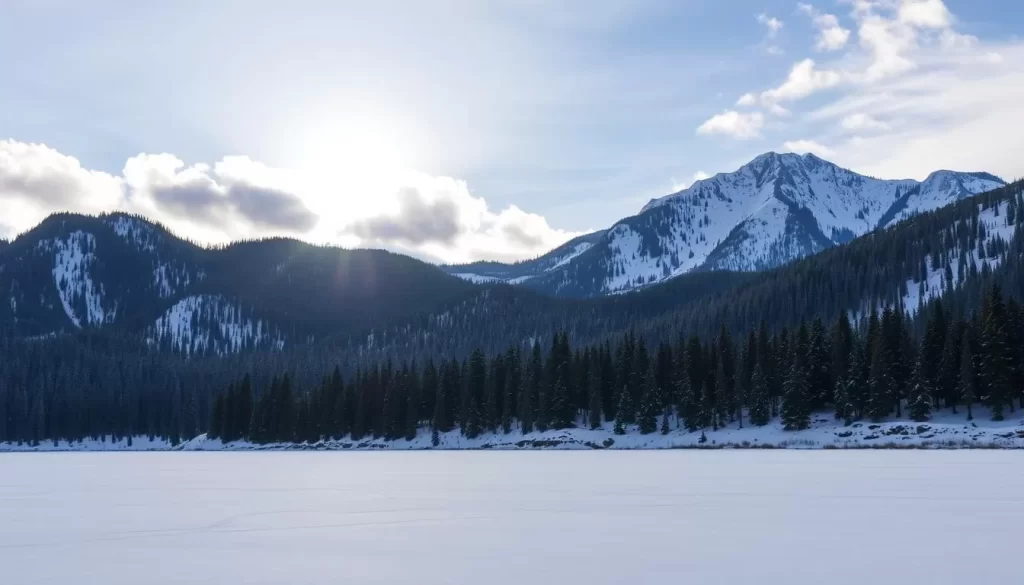
Despite these challenges, winter can be a great time of year to visit the Black Hills region if you’re looking for a peaceful and serene atmosphere. You can find accommodation deals and enjoy popular attractions without the crowds. With careful planning and preparation, you can have a wonderful winter adventure in the Black Hills region.
Spring Revival: March Through May
As spring unfolds, Sturgis, South Dakota, transforms into a vibrant destination. The season brings a mix of weather conditions, making it essential to plan your visit accordingly.
March’s Unpredictable Weather Patterns
March is a transitional month in Sturgis, characterized by unpredictable weather patterns. You can expect a mix of cold winter days and milder spring temperatures. It’s not uncommon to experience late-season snowstorms alongside early signs of spring.
April’s Warming Trends and Spring Bloom
April marks a significant warming trend in Sturgis, with temperatures gradually rising. The region begins to see the beauty of spring as flowers and greenery start to bloom. However, it’s still a relatively quiet period, making it an excellent time to explore without the crowds.
May’s Pleasant Conditions for Early Visitors
May is one of the best times of year to visit Sturgis, offering pleasant weather conditions. Average highs reach 66°F, while lows are around 45°F. It’s also the month with the most rain, averaging 2.5 inches. The spring bloom is in full swing, creating spectacular scenery throughout the Black Hills region.
- Enjoy comfortable daytime temperatures and mild evenings.
- Experience the full beauty of spring with vibrant greenery and wildflowers.
- Be prepared for occasional rain showers.
- Take advantage of relatively quiet conditions at major attractions before the peak tourist season.
Visiting Sturgis in the spring allows you to enjoy the region’s natural beauty without the peak season crowds. With proper planning and packing, you can have a wonderful time exploring this beautiful area.
Sturgis, South Dakota: Best Months for a Weather-Savvy Trip
To make the most of your trip to Sturgis, it’s essential to consider the time of year and weather conditions. Planning your visit during the optimal months can significantly enhance your experience.
Early June: The Perfect Balance
Early June offers a perfect balance of pleasant weather and smaller crowds, making it an ideal time to visit Sturgis. The temperatures are mild, and the scenery is particularly beautiful as the spring bloom is in full swing. You can enjoy outdoor activities like hiking and biking without the peak season crowds.
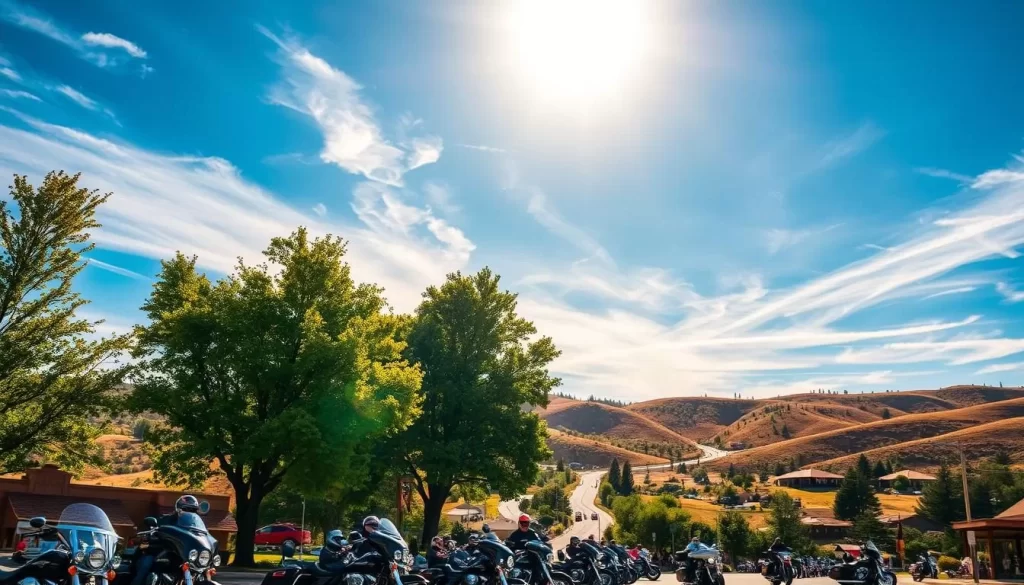
Late September: Post-Season Perfection
Late September is another excellent period to visit Sturgis. The summer crowds have dissipated, and the weather remains generally pleasant, with warm days and cooler nights. This period is ideal for those who prefer a more relaxed atmosphere and lower prices for accommodations.
Weather-Based Trip Planning Timeline
Creating a trip planning timeline based on weather is crucial for a successful trip to Sturgis. It’s recommended to start planning 3-6 months in advance to secure the best accommodations, especially during popular periods. Researching historical weather patterns and monitoring long-range forecasts can help you prepare for your trip.
When planning your trip, consider the time of year you visit to ensure it aligns with your preferences and activities. By doing so, you’ll be able to make the most of your travel experience in Sturgis and the Black Hills region.
The Sturgis Motorcycle Rally: Weather Considerations
When attending the Sturgis Motorcycle Rally, being prepared for various weather conditions is essential. The event, held in August, can experience a range of weather phenomena.
Typical Weather During Rally Week
During the Sturgis Motorcycle Rally, you can expect warm temperatures, with occasional heatwaves that may push the mercury into the 90s or even 100s Fahrenheit, although this is rare. Afternoon rain showers and thunderstorms are common due to the region’s topography. Despite the occasional rain, the low humidity in the Black Hills area makes the days more comfortable, even during the warmest summer days.
Preparing for Rally Weather Extremes
To make the most of your travel experience, it’s crucial to be prepared for the weather extremes. The history of the rally shows that severe thunderstorms can impact outdoor events. Here are some tips to help you prepare:
- Pack layers for significant temperature drops between day and night.
- Bring rain gear to protect against sudden thunderstorms.
- Stay hydrated due to the low humidity and potential heat.
- Check weather forecasts daily to plan your rides accordingly.
By being prepared, you can enjoy the rally to the fullest, regardless of the weather conditions.
Mount Rushmore and Black Hills: Seasonal Visitation Guide
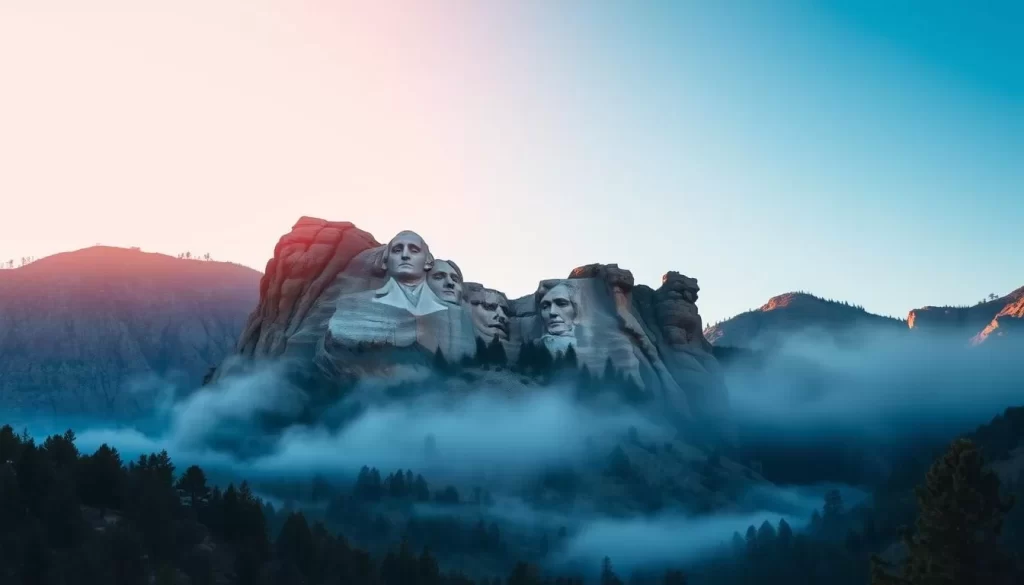
Visiting Mount Rushmore and the Black Hills is a year-round experience, with each season offering a distinct perspective on these iconic landmarks. The region’s diverse landscape and climate ensure that there’s always something new to enjoy, whether you’re interested in outdoor activities, photography, or simply taking in the view.
Weather Impact on Sightseeing Experience
The weather significantly impacts the sightseeing experience at Mount Rushmore and the Black Hills. Understanding the seasonal weather patterns can help you plan your visit to make the most of your time. For instance, the summer months offer warm weather and long days, ideal for hiking and exploring the area.
Seasonal Photography Opportunities
Each season presents unique photography opportunities at Mount Rushmore and throughout the Black Hills. The changing light, weather, and landscape conditions create diverse visual experiences. For example, summer provides the longest photography hours with extended daylight and the evening lighting ceremony, while fall brings golden hour lighting and vibrant autumn colors.
The best things to do in the area vary by season, but some activities remain popular throughout the year. Photography is one such activity, with the monument offering different opportunities throughout the year.
Badlands National Park: Weather-Optimized Visits
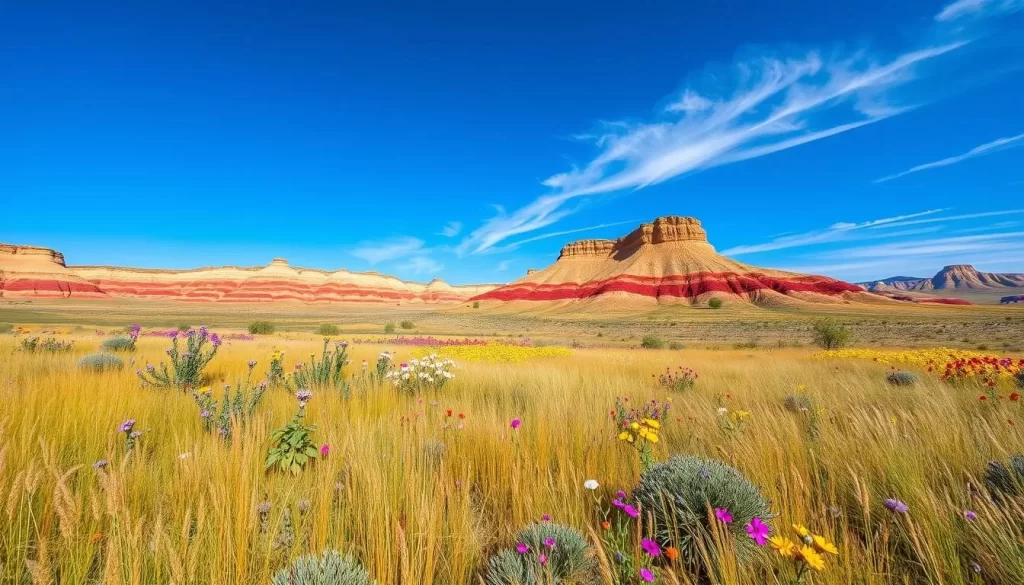
Visiting Badlands National Park requires careful planning, with weather being a key factor in determining the quality of your trip. The park’s unique landscape and open hiking policy make it a fascinating destination, but the weather can significantly impact your experience.
Extreme Temperature Variations
The Badlands are known for their extreme temperature fluctuations. Summer days can be very hot, while nights can be cool. In contrast, winter temperatures can drop significantly, making it essential to pack accordingly. Understanding these variations is crucial for planning your visit.
Ideal Months for Hiking
The ideal months for hiking and exploring Badlands National Park are May-early June and September-early October. During these periods, temperatures are moderate, and the landscape offers interesting features. Spring visits in May provide the opportunity to see the Badlands at their most vibrant, with prairie grasses and wildflowers creating a lush landscape. Early morning and evening hikes are recommended for better light and more comfortable temperatures.
Custer State Park Through the Seasons
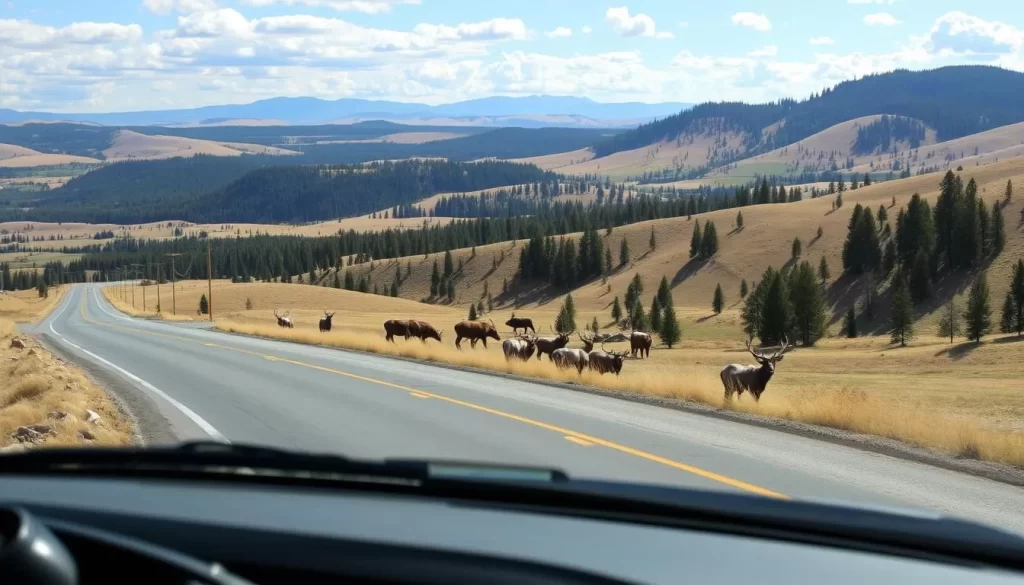
The beauty of Custer State Park unfolds differently with each season, making it a fascinating place to explore. As you plan your visit, understanding the seasonal changes can help you make the most of your trip. Whether you’re interested in wildlife viewing or enjoying the park’s scenic drives, each season offers unique experiences.
Wildlife Viewing Opportunities by Season
Custer State Park is renowned for its wildlife, including bison, elk, and deer. The changing seasons affect the behavior and visibility of these animals. In the spring, newborn animals are a delight to watch, while summer offers lush landscapes and active wildlife. Autumn brings the rutting season for elk, and winter provides opportunities to see animals in their natural habitats, often closer to roads and viewing areas.
Scenic Drives and Weather Considerations
Custer State Park’s famous scenic drives, including Needles Highway and Iron Mountain Road, offer different experiences throughout the year based on weather conditions. These drives are among the best things to do in the Black Hills region, featuring narrow tunnels, pigtail bridges, and spectacular vistas. Needles Highway typically closes during winter months (approximately October to April), making summer and early fall the best times to experience this engineering marvel. Spring drives feature blooming wildflowers, while fall transforms the landscapes with golden aspen groves and red sumac.
When planning your scenic drive, consider not just precipitation but also fog and low clouds, which can significantly impact visibility along these high-elevation routes. The weather plays a crucial role in determining the quality of your drive. By understanding the seasonal weather patterns, you can better plan your trip to Custer State Park and enjoy the scenic drives it has to offer throughout the year.
Outdoor Activities and Weather Timing
To make the most of your visit to Sturgis, it’s essential to consider the weather timing for different outdoor activities. The area offers a range of experiences, from hiking and biking to water sports, each with its optimal weather conditions.
Optimal Weather for Hiking and Biking
Hiking and biking are popular activities in the Sturgis area, with trails available for various skill levels. The best time for these activities is during the spring and early fall, when the weather is mild and comfortable. Summer can be hot, with the risk of afternoon thunderstorms, making morning or late afternoon the best time for these activities.
| Activity | Best Time | Weather Consideration |
|---|---|---|
| Hiking | Spring, Early Fall | Mild temperatures |
| Biking | Spring, Early Fall | Avoid peak summer heat |
Water Activities and Temperature
Water activities in the Sturgis area, such as paddleboarding, kayaking, and swimming, are highly dependent on temperature. The prime season for these activities is from mid-June through early September, when water temperatures are most comfortable. Sylvan Lake in Custer State Park is a popular spot, but water temperature varies throughout the year.
| Water Activity | Prime Season | Temperature Consideration |
|---|---|---|
| Paddleboarding | Mid-June to Early September | Comfortable water temperature |
| Swimming | July, August | Peak water temperature |
Accommodation Planning Based on Weather Seasons
The Black Hills region’s diverse weather patterns should influence your lodging decisions. When visiting Sturgis, South Dakota, it’s essential to consider the time of year and how it affects your accommodation choices.
Peak vs. Off-Season Availability and Pricing
During peak season, particularly around the Sturgis Motorcycle Rally, accommodation prices tend to be higher, and availability is limited. In contrast, off-season travel can offer more affordable rates and a wider range of choices. If you’re traveling during the winter months, consider lodging in places like Rapid City, which tends to have more reliable road access during snowstorms.
Weather-Related Lodging Considerations
When choosing your accommodations, consider the weather conditions you’ll face during your travel. Properties with indoor corridors can provide better comfort during both winter cold and summer heat. For trip planning, it’s also crucial to consider the possibility of weather delays and choose lodging with flexible cancellation policies, especially during spring and fall when conditions are less predictable.
Local Events and Festivals: Weather-Based Calendar
When planning your trip to Sturgis, it’s essential to consider the local events and festivals, as they are often weather-dependent. The area hosts a variety of activities throughout the year, each influenced by the prevailing weather conditions.
Annual Events and Their Typical Weather Conditions
Sturgis and its surrounding areas are known for their vibrant cultural scene, with events that reflect the changing seasons. For instance, the Sturgis Motorcycle Rally in August is typically hot, with temperatures often reaching the 90s°F (30s°C). In contrast, winter events like the Rapid City Winter Festival in December are cold, with temperatures usually in the 30s°F (around 0°C).
| Event | Month | Typical Weather |
|---|---|---|
| Sturgis Motorcycle Rally | August | Hot (90s°F) |
| Rapid City Winter Festival | December | Cold (30s°F) |
| Custer State Park Fall Festival | October | Mild (50s-60s°F) |
Indoor Alternatives During Weather Extremes
During weather extremes, Sturgis offers numerous indoor activities. You can visit museums like the Journey Museum in Rapid City or the Adams Museum in Deadwood to learn about the region’s history and culture. Additionally, the Jewel Cave National Monument and Wind Cave National Park provide stable underground temperatures, making them ideal for visits during extreme weather. You can also enjoy activities like gaming in Deadwood or exploring places like art galleries and wineries in the area.
- Museums: Journey Museum, Adams Museum
- Cave Tours: Jewel Cave National Monument, Wind Cave National Park
- Gaming Halls: Historic buildings in Deadwood
- Art Galleries: Showcasing local and Native American crafts
- Wineries and Breweries: Offering tastings and tours
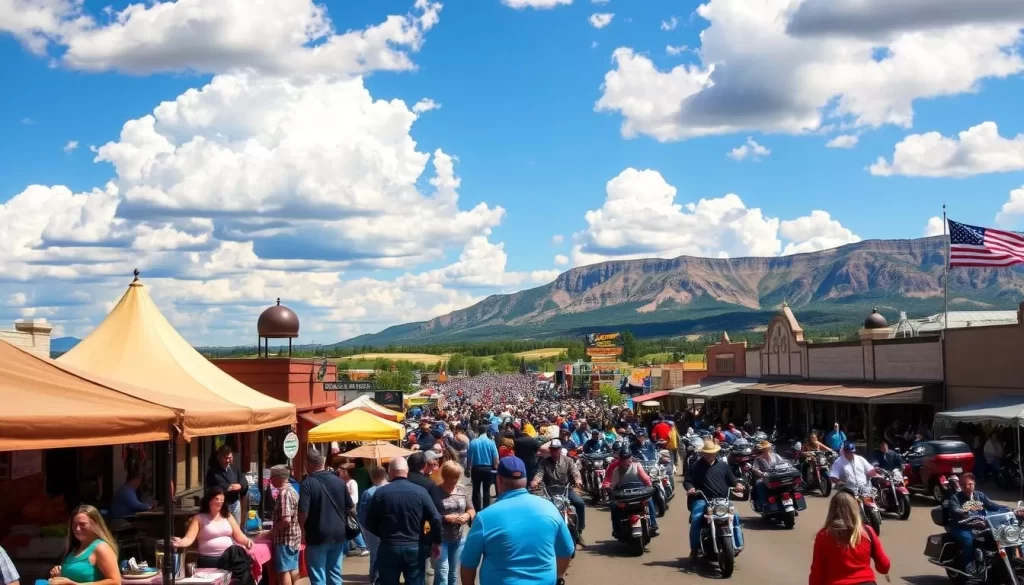
Conclusion: Creating Your Weather-Perfect Sturgis Itinerary
Planning a trip to Sturgis requires considering the weather and activities available during different times of the year. The Black Hills region offers a unique experience throughout the year, making it essential to balance your preferences with the activities you want to enjoy.
To create a trip planning strategy, consider the shoulder seasons (late May to early June or September to early October) for ideal conditions. Be sure to incorporate weather contingencies and flexible scheduling to accommodate any unexpected changes.
Ultimately, the best things to do in Sturgis depend on your interests and the season you visit. With proper planning, you can have a memorable trip, enjoying the natural landscapes and outdoor activities that this remarkable region has to offer, regardless of the time of year.
The above is subject to change.
Check back often to TRAVEL.COM for the latest travel tips and deals.
